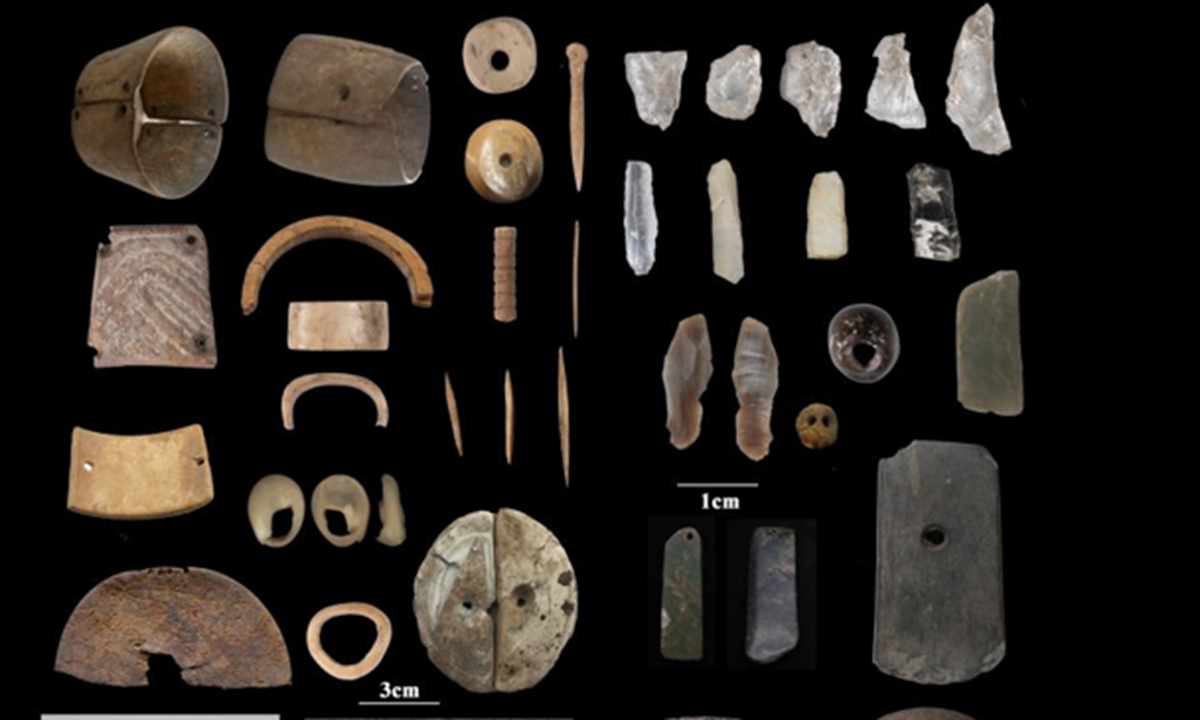
Relics excavated from the Neolithic Mabucuo Site Photo: Xinhua
The institute of cultural relics protection in Southwest China's Xizang Autonomous Region has announced progress has been made at multiple archaeological sites in the region, saying these new discoveries highlight unity in diversity of Chinese civilization.
Since 2021, the institute has collaborated with 12 Chinese research institutions on 34 proactive archaeological excavations at 17 ancient sites and tombs, which range from the Paleolithic and Neolithic to the Early Metal Ages in seven areas of Xizang, Li Linhui, director of the institute, told the Global Times on Thursday.
Archaeological finds at the Paleolithic sites, including the Shanggagang Site, Xiuma Cave and Gani Site, have provided important evidence for understanding how early humans explored and adapted to life on the Qinghai-Xizang Plateau, and how these people communicated with surrounding regions, the Xinhua News Agency reported, citing the institute's announcement concerning the 2024 Xizang archaeology work briefing on Wednesday.
Discoveries at the Neolithic sites of Mabucuo and Lapo reveal the cultural inheritance and exchanges between prehistoric populations in the high-altitude interior of the Qinghai-Xizang Plateau and surrounding regions, providing strong evidence for unity in diversity of Chinese civilization, according to the regional institute.
Particularly, the Mabucuo Site, which dates from 4,800 to 2,000 years ago, is currently the highest, earliest, longest, and most culturally continuous Neolithic lakeside site discovered on the plateau, said the institute.
The archaeological discoveries at the Sangdalongguo Tomb and the Kuoxiong Site have provided data for the study of the Early Metal Age on the Qinghai-Xizang Plateau. While findings from the Sangdalongguo Tomb suggest the emergence of social stratification at the time, artifacts unearthed at the Kuoxiong Site show similarities with those found in the western part of Southwest China's Sichuan Province, indicating possible cultural exchanges between these regions.
The relics excavated from the Wenjiangduo Site, which has a history of over 1,000 years, show that close cultural ties existed between the Qinghai-Xizang Plateau, the Central Plains in the Tang Dynasty (618-907) and neighboring regions, offering key evidence of multiethnic interaction along the South Asian corridor of the Silk Road since the 7th century.
The institute said the archaeological surveys, excavations, and research efforts in Xizang in recent years preliminarily have established the archaeological cultural framework of the Qinghai-Xizang Plateau, while significant progress has been made in building a comprehensive archaeological resource information system for Xizang.
"A large number of archaeological findings reveal that humans arrived at the heart of the Qinghai-Xizang Plateau 100,000 years ago. Different stages of archaeological cultures developed and flourished in Xizang. The archaeological findings vividly demonstrate the historical facts that Xizang is an important component of the unity in diversity structure of the Chinese nation," Li said as reported by Xinhua.




